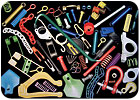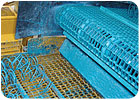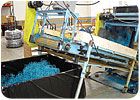Quenching Metal with Coatings
How can you improve the quality and profitability of your heat treating operation? Try water-based quench coatings. These coatings use the residual heat in the parts to dry them efficiently. The parts are then ready for immediate shipment, bypassing the need for secondary finishing processes that are labor intensive and expensive, and thus expediting the manufacturing process.

In today’s competitive marketplace, companies seek new, cost-effective methods to improve their manufacturing processes and, ultimately, their final product. Innovations in water-based coatings are providing low-cost and eco-friendly options that protect heat-treated metal products and result in an aesthetic finishing coat, increasing their product’s appeal to end users.
One such innovation is water-based quench coatings, which can be used to replace traditional quench fluids. When positioned in-line with heat-treating operations, water-based quench coatings use the residual heat in the parts to dry efficiently. The parts are then ready for immediate shipment, bypassing the need for secondary finishing processes that are labor intensive and expensive, thus expediting the manufacturing process.
Quenching in colored, water-based polymer coatings replaces processes such as oiling, painting and plating that use hazardous materials and require waste processing. Manufacturers can use water-based coatings in place of the oils and polymeric compositions that are traditionally part of the final step in heat treating.
Integrating water-based quench coatings can eliminate the need to pretreat parts before heat treating. Because the coatings can penetrate scale and rust, parts with water-based coatings usually do not need to be pretreated or cleaned unless they have an oil coating that isn’t removed during heat treating. Additionally, because manufacturers do not need to paint, clean or handle the products, they enjoy reduced labor costs.
These coatings are effective for protecting castings, forgings and other heat-treated parts made of any metal substrate, including steel, iron, aluminum, brass and bronze. Manufacturers can also use water-based quench coatings as solid film lubrication for fasteners and bearings, a primer and undercoating for metal products, or coating on metal components for processing, drawing or stamping.

Low VOCs. Most water-based quench coatings have low volatile organic compounds (VOCs) compared to other coating processes in manufacturing. The amount of VOCs in waterborne coatings is typically between 0.1 to 0.9 lb/gal minus water.
Unless specifically requested, the dried coatings contain no hazardous compounds - an extremely important feature, as they can displace oiling, painting and plating, which are not environmentally friendly. When used properly, water-based coating baths provide manufacturers with a safer working environment for employees.
Corrosion Resistance. Coated parts have demonstrated a high level of corrosion protection during real-world exposure. Agricultural tools quenched in a waterborne coating, for example, have shown minimal corrosion and remained well protected after being exposed to the elements for more than two years.
Humidity Resistance. Some water-based quench coatings have undergone repeated water resistance testing under ASTM D2247 (100% relative humidity, 100°F). The coatings provided 100 to 200 hours of protection at 1 mil (25 microns) after seven days of drying time. Bolts dipped in waterborne quench coatings showed only minimal deterioration (3% rust) as per ASTM D610, the standard test method for evaluating the degree of rusting on painted steel surfaces.
Automatic Transmission Fluid Resistance. Some coatings conform to General Motors’ (Allison Transmission) specification TMS 26915 for transmissions. Following 72-hour immersion in various transmission fluids at 250°F, springs quenched in waterborne coatings showed no softening, loss of adhesion or discoloration.
To establish the best operating parameters for water-based coatings in a production line, manufacturers should use the following steps as a guide:
After the proper guidelines have been established, using waterborne coatings is a simple process. The operator submerses heated parts (300 to 1700°F) in a temperature-controlled, water-reducible polymer bath for five to 50 seconds. The exact timing depends on the part’s size, its required removal temperature for proper drying and the desired coating thickness. After drying, parts are ready for additional processing, packaging or shipment.

pH Testing. A pH meter monitors the alkalinity of water-based quench baths. The pH range normally used in these quench baths is 8 to 9. Maintaining pH within this range promotes compatibility between water and the coating polymer used for quenching.
In normal day-to-day operations, the pH of the polymers tends to drop - they will be less alkaline. With routine analysis, manufacturers can discover these downward drifts in pH and correct them before the manufacturing process is interrupted. Small, frequent additions of fresh quench bath concentrate should keep the pH in check. If additional pH correction is necessary, operators can add small amounts of ammonia.
Monitoring Weight Percent Solids. Monitoring the weight percent solids enables manufacturers to determine the percentages of liquid and solid portions of the quench bath. The solid portion controls the thickness of the coating that deposits on the heated metal parts. With water-based coatings, as the concentration of the bath increases, so does the coating’s thickness.
Upon startup, operators reduce the quench bath concentration using water. Depending on several factors - preheat temperature, desired thickness, and the number of parts to be quenched - the concentrate may be reduced to 3:1, 1:1 concentrate to water ratio or some other reduction ratio as a starting point. This will help set parameters for the reduction ratio that leads to the desired finished product.
At this point, a weight percent solids determination should be made to establish the weight percent solids concentration at which a finished product will be processed. Operators can maintain this level by adding water or quench bath concentrate. If solids exceed the desired range, excessive coating may occur, resulting in blisters, craters or a “festered” appearance. Conversely, if solids levels decrease below the desired range, the coating’s thickness will drop, resulting in less coverage and a washed-out appearance.
Houghton International markets ThermadepSM water-based quench coatings to the metalworking industry through a partnership with Egyptian Coatings, Franklin, TN. For more information, visit www.houghtonintl.com.

Water-based quench coatings are available in a range of colors and can be used on a variety of different parts.
In today’s competitive marketplace, companies seek new, cost-effective methods to improve their manufacturing processes and, ultimately, their final product. Innovations in water-based coatings are providing low-cost and eco-friendly options that protect heat-treated metal products and result in an aesthetic finishing coat, increasing their product’s appeal to end users.
One such innovation is water-based quench coatings, which can be used to replace traditional quench fluids. When positioned in-line with heat-treating operations, water-based quench coatings use the residual heat in the parts to dry efficiently. The parts are then ready for immediate shipment, bypassing the need for secondary finishing processes that are labor intensive and expensive, thus expediting the manufacturing process.
Quenching in colored, water-based polymer coatings replaces processes such as oiling, painting and plating that use hazardous materials and require waste processing. Manufacturers can use water-based coatings in place of the oils and polymeric compositions that are traditionally part of the final step in heat treating.
Integrating water-based quench coatings can eliminate the need to pretreat parts before heat treating. Because the coatings can penetrate scale and rust, parts with water-based coatings usually do not need to be pretreated or cleaned unless they have an oil coating that isn’t removed during heat treating. Additionally, because manufacturers do not need to paint, clean or handle the products, they enjoy reduced labor costs.
These coatings are effective for protecting castings, forgings and other heat-treated parts made of any metal substrate, including steel, iron, aluminum, brass and bronze. Manufacturers can also use water-based quench coatings as solid film lubrication for fasteners and bearings, a primer and undercoating for metal products, or coating on metal components for processing, drawing or stamping.

Water-based quench-coated springs entering a dryer oven.
Coating Properties
Water-based quench coatings are well-suited for manufacturing a variety of heat-treated metal products. They provide uniform, low-gloss finishes that can resist runs, sags, blisters and other surface imperfections. While a low-gloss black finish is the most commonly used, the coatings are available in a palate of 15 colors, including silver, gold and clears. They also possess other beneficial properties.Low VOCs. Most water-based quench coatings have low volatile organic compounds (VOCs) compared to other coating processes in manufacturing. The amount of VOCs in waterborne coatings is typically between 0.1 to 0.9 lb/gal minus water.
Unless specifically requested, the dried coatings contain no hazardous compounds - an extremely important feature, as they can displace oiling, painting and plating, which are not environmentally friendly. When used properly, water-based coating baths provide manufacturers with a safer working environment for employees.
Corrosion Resistance. Coated parts have demonstrated a high level of corrosion protection during real-world exposure. Agricultural tools quenched in a waterborne coating, for example, have shown minimal corrosion and remained well protected after being exposed to the elements for more than two years.
Humidity Resistance. Some water-based quench coatings have undergone repeated water resistance testing under ASTM D2247 (100% relative humidity, 100°F). The coatings provided 100 to 200 hours of protection at 1 mil (25 microns) after seven days of drying time. Bolts dipped in waterborne quench coatings showed only minimal deterioration (3% rust) as per ASTM D610, the standard test method for evaluating the degree of rusting on painted steel surfaces.
Automatic Transmission Fluid Resistance. Some coatings conform to General Motors’ (Allison Transmission) specification TMS 26915 for transmissions. Following 72-hour immersion in various transmission fluids at 250°F, springs quenched in waterborne coatings showed no softening, loss of adhesion or discoloration.
Establishing Operating Parameters
Before diving into water-based coatings, manufacturers must evaluate their basic coating and finishing needs. They must choose the best set of operating parameters, whether they are proposing to quench parts in a conveyor-type system or in a batch process where up to several hundred parts are coated at once.To establish the best operating parameters for water-based coatings in a production line, manufacturers should use the following steps as a guide:
- Clean and degrease parts in lacquer thinner or other suitable solvents. Manufacturers often omit this step because conventional processing rarely includes cleaning.
- Hang cleaned parts on hooks, place in mesh baskets or on a conveyor.
- Heat parts to the temperature that approximates the heat used in a regular heat treating process.
- Prepare the quench bath by reducing the coating’s concentrate with a sufficient amount of water. If the bath is used to coat small parts, two parts concentrate to one part water is a good starting point. If a large number of parts require coating, a weaker bath consisting of one part concentrate to two parts water may be a better option. Mix small portions of the bath with appropriate amounts of water to determine which mix yields the highest number of coated parts, achieving the ideal concentration. Once established, maintain the quench bath at this ratio.
- After parts are heat treated, remove them from the oven quickly and immediately immerse them in the quench bath. Swirl the parts around to simulate fluid motion in the quench tank. They should remain in the tank long enough to drop their temperature to between 90 and 140°F. This is the most important step in the process. If too much time elapses after removing the parts from the oven, the coating process will fail. Hotter parts will dry faster when they are removed from the bath, but if parts are removed too quickly, the coating may blister. Determine a balance by running a series of varying quench times.
- Shake or spin the coated parts to remove excess coating.
- Direct air from small fans over freshly coated parts to speed the drying process.
After the proper guidelines have been established, using waterborne coatings is a simple process. The operator submerses heated parts (300 to 1700°F) in a temperature-controlled, water-reducible polymer bath for five to 50 seconds. The exact timing depends on the part’s size, its required removal temperature for proper drying and the desired coating thickness. After drying, parts are ready for additional processing, packaging or shipment.

Water-based quench-coated springs exiting a dryer oven.
Quality Quench Control
One of the most important considerations of operating a tank filled with water-based coatings is maintaining the quality of the quench bath. The quality of the process will be influenced by the physical condition of the various quench tanks, so consistency in the bath’s composition is imperative. Daily operations should control measures of acidity-alkalinity (pH) and the solid materials that form the coatings (weight percent solids). Routine measurement and analysis will encourage good results.pH Testing. A pH meter monitors the alkalinity of water-based quench baths. The pH range normally used in these quench baths is 8 to 9. Maintaining pH within this range promotes compatibility between water and the coating polymer used for quenching.
In normal day-to-day operations, the pH of the polymers tends to drop - they will be less alkaline. With routine analysis, manufacturers can discover these downward drifts in pH and correct them before the manufacturing process is interrupted. Small, frequent additions of fresh quench bath concentrate should keep the pH in check. If additional pH correction is necessary, operators can add small amounts of ammonia.
Monitoring Weight Percent Solids. Monitoring the weight percent solids enables manufacturers to determine the percentages of liquid and solid portions of the quench bath. The solid portion controls the thickness of the coating that deposits on the heated metal parts. With water-based coatings, as the concentration of the bath increases, so does the coating’s thickness.
Upon startup, operators reduce the quench bath concentration using water. Depending on several factors - preheat temperature, desired thickness, and the number of parts to be quenched - the concentrate may be reduced to 3:1, 1:1 concentrate to water ratio or some other reduction ratio as a starting point. This will help set parameters for the reduction ratio that leads to the desired finished product.
At this point, a weight percent solids determination should be made to establish the weight percent solids concentration at which a finished product will be processed. Operators can maintain this level by adding water or quench bath concentrate. If solids exceed the desired range, excessive coating may occur, resulting in blisters, craters or a “festered” appearance. Conversely, if solids levels decrease below the desired range, the coating’s thickness will drop, resulting in less coverage and a washed-out appearance.
A Competitive Option
Manufacturers can implement water-based quench coatings in existing heat-treating operations at a low capital expense. These low-VOC coatings provide corrosion and wear resistance, ductility and lubricity, and come in a variety of colors. Even more importantly, these coatings can increase profitability by eliminating the extra costs of separate painting operations, which can give companies a competitive edge.Houghton International markets ThermadepSM water-based quench coatings to the metalworking industry through a partnership with Egyptian Coatings, Franklin, TN. For more information, visit www.houghtonintl.com.
Looking for a reprint of this article?
From high-res PDFs to custom plaques, order your copy today!







